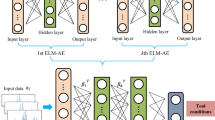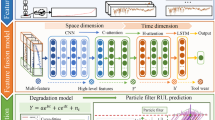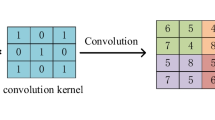Abstract
On-machine monitoring of tool wear is of great significance in machining processes to enhance machining efficiencies and reduce cost. For the data-driven tool wear prediction, the consistent feature distribution is critical to the machining learning model. In CNC machining of complex parts, the data distribution is complex due to the time-varying operational parameters. Even the considered as perform well of transfer learning methods may not mine consistent feature distribution representations and may not explain the transferable components to break through the bottleneck of prediction performance. The attention mechanism has shown its unique advantages with the adaptive weighted structure to capture the specific feature in tool wear state prediction. In order to further capture the specific characteristic frequencies and determine the specific transferable components for different working conditions and enhance the performance of cross-domain tool wear prediction, we propose a new cross-domain adaptation network based on attention mechanism(CDATT). Firstly, a data filtering method based on the singular value decomposition and mixed Gaussian model is proposed for removing the idling signals to avoid the effects of invalid samples adaptively. Then, the attention mechanism is introduced to build a prediction network for highlighting the specific tool wear frequency and making the wear characteristic more significant. Next, the joint distribution adaptation regularization term is utilized to construct a network loss function to build the CDATT model for different working conditions. Finally, experiments are carried out on a machine tool to verify the effectiveness of the proposed method. The result shows that the proposed CDATT model can capture the specific tool wear frequency and identify the tool wear state accurately under different machining parameters.




















Similar content being viewed by others
References
Agogino, A. & Goebel, K. Best lab. in: Uc berkeley, milling data set. nasa ames prognostics data repository. http://ti.arc.nasa.gov/project/prognostic-data-repository (2007).
Bahdanau, D., Cho, K. & Bengio, Y. Neural machine translation by jointly learning to align and translate. arXiv preprint arXiv:1409.0473 (2014) .
Banerjee, A. & Ghosh, J. Clickstream clustering using weighted longest common subsequences, Vol. 143, 144 (organizationCiteseer, 2001).
Benkedjouh, T., Medjaher, K., Zerhouni, N., & Rechak, S. (2015). Health assessment and life prediction of cutting tools based on support vector regression. Journal of Intelligent Manufacturing, 26(2), 213–223.
Bergstra, J., Bardenet, R., Bengio, Y. & Kégl, B. Algorithms for hyper-parameter optimization. Advances in neural information processing systems 24 (2011) .
Bisu, C. F., Zapciu, M., Cahuc, O., Gérard, A., & Anica, M. (2012). Envelope dynamic analysis: a new approach for milling process monitoring. The International Journal of Advanced Manufacturing Technology, 62(5), 471–486.
Boutros, T., & Liang, M. (2011). Detection and diagnosis of bearing and cutting tool faults using hidden markov models. Mechanical Systems and Signal Processing, 25(6), 2102–2124.
Brili, N., Ficko, M., & Klančnik, S. (2021). Automatic identification of tool wear based on thermography and a convolutional neural network during the turning process. Sensors, 21(5), 1917.
Cai, W., Zhang, W., Hu, X., & Liu, Y. (2020). A hybrid information model based on long short-term memory network for tool condition monitoring. Journal of Intelligent Manufacturing, 31(6), 1497–1510.
Chang, C.-C., & Lin, C.-J. (2011). Libsvm: a library for support vector machines. ACM Transactions on Intelligent Systems and Technology (TIST), 2(3), 1–27.
Chang, W.-Y., Wu, S.-J., & Hsu, J.-W. (2020). Investigated iterative convergences of neural network for prediction turning tool wear. The International Journal of Advanced Manufacturing Technology, 106(7), 2939–2948.
Colantonio, L., Equeter, L., Dehombreux, P., & Ducobu, F. (2021). A systematic literature review of cutting tool wear monitoring in turning by using artificial intelligence techniques. Machines, 9(12), 351.
Collobert, R. & Weston, J. A unified architecture for natural language processing: Deep neural networks with multitask learning, 160–167 (2008).
Creswell, A., et al. (2018). Generative adversarial networks: An overview. IEEE Signal Processing Magazine, 35(1), 53–65.
Dempster, A. P., Laird, N. M., & Rubin, D. B. (1977). Maximum likelihood from incomplete data via the em algorithm. Journal of the Royal Statistical Society: Series B (Methodological), 39(1), 1–22.
Ding, Y., Jia, M., Miao, Q., & Cao, Y. (2022). A novel time-frequency transformer based on self-attention mechanism and its application in fault diagnosis of rolling bearings. Mechanical Systems and Signal Processing, 168, 108616.
Dou, J., et al. (2020). An unsupervised online monitoring method for tool wear using a sparse auto-encoder. The International Journal of Advanced Manufacturing Technology, 106(5), 2493–2507.
Eren, L., Ince, T., & Kiranyaz, S. (2019). A generic intelligent bearing fault diagnosis system using compact adaptive 1d cnn classifier. Journal of Signal Processing Systems, 91(2), 179–189.
Ester, M., Kriegel, H.-P., Sander, J., Xu, X., et al. (1996). A density-based algorithm for discovering clusters in large spatial databases with noise.,96, 226–231.
Fowlkes, E. B., & Mallows, C. L. (1983). A method for comparing two hierarchical clusterings. Journal of the American Statistical Association, 78(383), 553–569.
Fu, J., Zheng, H. & Mei, T. Look closer to see better: Recurrent attention convolutional neural network for fine-grained image recognition, 4438–4446 (2017).
Ganin, Y., et al. (2016). Domain-adversarial training of neural networks. The Journal of Machine Learning Research, 17(1), 2030–2096.
Goebel, K. F. Management of uncertainty in sensor validation, sensor fusion, and diagnosis of mechanical systems using soft computing techniques (publisherUniversity of California, Berkeley, 1996).
Gong, B., Shi, Y., Sha, F. & Grauman, K. Geodesic flow kernel for unsupervised domain adaptation, 2066–2073 (organizationIEEE, 2012).
Goodfellow, I. et al. Generative adversarial nets. Advances in neural information processing systems 27 (2014) .
He, Z., Shi, T., Xuan, J., & Li, T. (2021). Research on tool wear prediction based on temperature signals and deep learning. Wear, 478, 203902.
Hinton, G. E., & Salakhutdinov, R. R. (2006). Reducing the dimensionality of data with neural networks. Science, 313(5786), 504–507.
Hubert, L., & Arabie, P. (1985). Comparing partitions. Journal of Classification, 2(1), 193–218.
Kanagawa, H., Kobayashi, H., Shimizu, N., Tagami, Y. & Suzuki, T. Cross-domain recommendation via deep domain adaptation, 20–29 (organizationSpringer, 2019).
Keogh, E. J. & Pazzani, M. J. Derivative dynamic time warping, 1–11 (organizationSIAM, 2001).
Kingma, D. P. & Ba, J. Adam: A method for stochastic optimization. arXiv preprint arXiv:1412.6980 (2014) .
LeCun, Y., Bengio, Y., & Hinton, G. (2015). Deep learning. Nature, 521(7553), 436–444.
Lei, Y., et al. (2018). Machinery health prognostics: A systematic review from data acquisition to rul prediction. Mechanical Systems and Signal Processing, 104, 799–834.
Lei, Y., et al. (2020). Applications of machine learning to machine fault diagnosis: A review and roadmap. Mechanical Systems and Signal Processing, 138, 106587.
Lei, Z., Zhou, Y., Sun, B., & Sun, W. (2020). An intrinsic timescale decomposition-based kernel extreme learning machine method to detect tool wear conditions in the milling process. The International Journal of Advanced Manufacturing Technology, 106(3), 1203–1212.
Li, X., Zhang, W., & Ding, Q. (2019). Understanding and improving deep learning-based rolling bearing fault diagnosis with attention mechanism. Signal Processing, 161, 136–154.
Li, J., Lu, J., Chen, C., Ma, J., & Liao, X. (2021). Tool wear state prediction based on feature-based transfer learning. The International Journal of Advanced Manufacturing Technology, 113(11), 3283–3301.
Liao, X., Zhou, G., Zhang, Z., Lu, J., & Ma, J. (2019). Tool wear state recognition based on gwo-svm with feature selection of genetic algorithm. The International Journal of Advanced Manufacturing Technology, 104(1), 1051–1063.
Liu, J., Ji, S. & Ye, J. Multi-task feature learning via efficient l2, 1-norm minimization. arXiv preprint arXiv:1205.2631 (2012) .
Long, M., Wang, J., Ding, G., Sun, J. & Yu, P. S. Transfer feature learning with joint distribution adaptation, 2200–2207 (2013).
Maciel, L., Ballini, R., & Gomide, F. (2016). Evolving granular analytics for interval time series forecasting. Granular Computing, 1(4), 213–224.
MacQueen, J. et al. Some methods for classification and analysis of multivariate observations, Vol. 1, 281–297 (organizationOakland, CA, USA, 1967).
Madhusudana, C., Budati, S., Gangadhar, N., Kumar, H., & Narendranath, S. (2016). Fault diagnosis studies of face milling cutter using machine learning approach. Journal of Low Frequency Noise, Vibration and Active Control, 35(2), 128–138.
Madhusudana, C., Gangadhar, N., Kumar, H., Narendranath, S., et al. (2018). Use of discrete wavelet features and support vector machine for fault diagnosis of face milling tool. Structural Durability & Health Monitoring, 12(2), 111.
Mamledesai, H., Soriano, M. A., & Ahmad, R. (2020). A qualitative tool condition monitoring framework using convolution neural network and transfer learning. Applied Sciences, 10(20), 7298.
Mao, W., Chen, J., Liu, J. & Liang, X. Self-supervised deep domain-adversarial regression adaptation for online remaining useful life prediction of rolling bearing under unknown working condition. IEEE Transactions on Industrial Informatics (2022) .
Mao, W., Liu, J., Chen, J., & Liang, X. (2022). An interpretable deep transfer learning-based remaining useful life prediction approach for bearings with selective degradation knowledge fusion. IEEE Transactions on Instrumentation and Measurement, 71, 1–16.
Marei, M., El Zaatari, S., & Li, W. (2021). Transfer learning enabled convolutional neural networks for estimating health state of cutting tools. Robotics and Computer-Integrated Manufacturing, 71, 102145.
Mnih, V., Heess, N., Graves, A. et al. Recurrent models of visual attention. Advances in neural information processing systems 27 (2014).
Nie, P., Xu, H., Liu, Y., Liu, X. & Li, Z. Aviation tool wear states identifying based on emd and svm, 246–249 (organizationIEEE, 2011).
Niehues, J. & Cho, E. Exploiting linguistic resources for neural machine translation using multi-task learning. arXiv preprint arXiv:1708.00993 (2017) .
Ou, J., Li, H., Huang, G., & Yang, G. (2021). Intelligent analysis of tool wear state using stacked denoising autoencoder with online sequential-extreme learning machine. Measurement, 167, 108153.
Pan, S. J., Tsang, I. W., Kwok, J. T., & Yang, Q. (2010). Domain adaptation via transfer component analysis. IEEE Transactions on Neural Networks, 22(2), 199–210.
SK, T. & Shankar, S. Tool wear prediction in hard turning of en8 steel using cutting force and surface roughness with artificial neural network. Proceedings of the Institution of Mechanical Engineers, Part C: Journal of Mechanical Engineering Science 234 (1), 329–342 (2020) .
Salam, A., & El Hibaoui, A. (2021). Energy consumption prediction model with deep inception residual network inspiration and lstm. Mathematics and Computers in Simulation, 190, 97–109.
Sevakula, R. K., Singh, V., Verma, N. K., Kumar, C., & Cui, Y. (2018). Transfer learning for molecular cancer classification using deep neural networks. IEEE/ACM Transactions on Computational Biology and Bioinformatics, 16(6), 2089–2100.
Shifat, T. A., & Jang-Wook, H. (2020). Remaining useful life estimation of bldc motor considering voltage degradation and attention-based neural network. IEEE Access, 8, 168414–168428.
Snoek, J., Larochelle, H. & Adams, R. P. Practical bayesian optimization of machine learning algorithms. Advances in neural information processing systems 25 (2012) .
Soualhi, M., Nguyen, K. T., & Medjaher, K. (2020). Pattern recognition method of fault diagnostics based on a new health indicator for smart manufacturing. Mechanical Systems and Signal Processing, 142, 106680.
Steinley, D. (2004). Properties of the hubert-arable adjusted rand index. Psychological Methods, 9(3), 386.
Tobon-Mejia, D. A., Medjaher, K., & Zerhouni, N. (2012). Cnc machine tool’s wear diagnostic and prognostic by using dynamic bayesian networks. Mechanical Systems and Signal Processing, 28, 167–182.
Van der Maaten, L., & Hinton, G. (2008). Visualizing data using t-sne. Journal of Machine Learning Research, 9(11), 112.
Vaswani, A. et al. Attention is all you need 30 (2017). https://proceedings.neurips.cc/paper/2017/file/3f5ee243547dee91fbd053c1c4a845aa-Paper.pdf.
Vinh, N. X., Epps, J., & Bailey, J. (2010). Information theoretic measures for clusterings comparison: Variants, properties, normalization and correction for chance. The Journal of Machine Learning Research, 11, 2837–2854.
Wang, F. et al. Residual attention network for image classification, 3156–3164 (2017).
Wang, M., & Deng, W. (2018). Deep visual domain adaptation: A survey. Neurocomputing, 312, 135–153.
Yao, J., Lu, B., & Zhang, J. (2022). Tool remaining useful life prediction using deep transfer reinforcement learning based on long short-term memory networks. The International Journal of Advanced Manufacturing Technology, 118(3), 1077–1086.
Yin, C., et al. (2021). Early fault diagnosis of ball screws based on 1-d convolution neural network and orthogonal design. Proceedings of the Institution of Mechanical Engineers, Part O: Journal of Risk and Reliability, 235(5), 783–797.
Yin, C., et al. (2021). Robust wheel wear detection for solid carbide grinding under strong noise interference: A new approach based on improved ensemble noise-reconstructed empirical mode decomposition. Wear, 486, 204112.
Yin, C., et al. (2022). Weak fault feature extraction of rolling bearings based on improved ensemble noise-reconstructed emd and adaptive threshold denoising. Mechanical Systems and Signal Processing, 171, 108834.
Zhou, B., Cheng, C., Ma, G. & Zhang, Y. Remaining useful life prediction of lithium-ion battery based on attention mechanism with positional encoding, Vol. 895, 012006 (organizationIOP Publishing, 2020).
Zhou, G., Yang, X., Zhang, C., Li, Z., & Xiao, Z. (2019). Deep learning enabled cutting tool selection for special-shaped machining features of complex products. Advances in Engineering Software, 133, 1–11.
Acknowledgements
This work was supported by the National Key Research and Development Program of China (2021YFB2012104), National Natural Science Foundation of China (52075267,52005332).
Author information
Authors and Affiliations
Corresponding author
Ethics declarations
Conflict of interest
We declare that we do not have any commercial or associative interest that represents a conflict of interest in connection with the work submitted.
Additional information
Publisher's Note
Springer Nature remains neutral with regard to jurisdictional claims in published maps and institutional affiliations.
Rights and permissions
Springer Nature or its licensor holds exclusive rights to this article under a publishing agreement with the author(s) or other rightsholder(s); author self-archiving of the accepted manuscript version of this article is solely governed by the terms of such publishing agreement and applicable law.
About this article
Cite this article
He, J., Sun, Y., Yin, C. et al. Cross-domain adaptation network based on attention mechanism for tool wear prediction. J Intell Manuf 34, 3365–3387 (2023). https://doi.org/10.1007/s10845-022-02005-z
Received:
Accepted:
Published:
Issue Date:
DOI: https://doi.org/10.1007/s10845-022-02005-z




